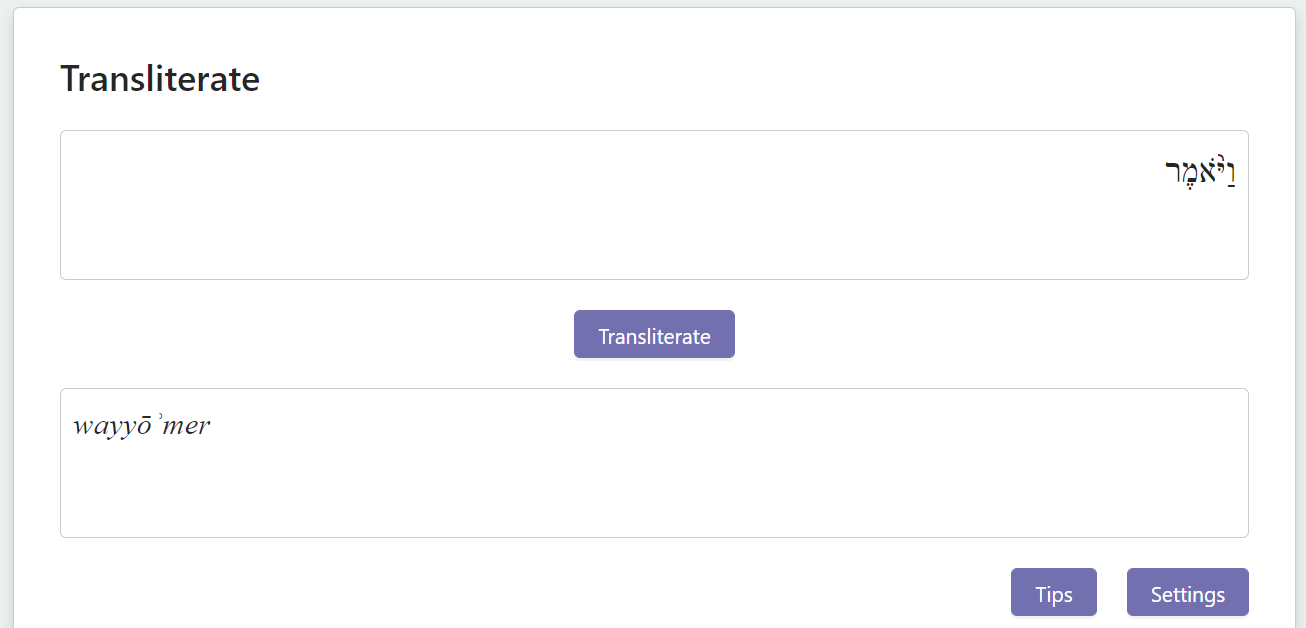Toponyms in the Bible
From the home page (an English option appears when you open the site):
Über odb
odb ist eine wissenschaftlich fundierte, kostenlos zugängliche Datenbank. Ziel ist es, zu allen biblischen Ortsangaben möglichst umfangreiche philologische, historische, archäologische, bibliographische und kartographische Informationen bereitzustellen.
Die Datenbank wurde in einem von der Deutschen Forschungsgemeinschaft (DFG) geförderten Projekt zu den Ortsangaben im Buch Genesis grundlegend erstellt.
Die Datenbank odb unterscheidet sich von vergleichbaren Projekten in mehreren Punkten:
- Die Arbeit an der Datenbank wird kontinuierlich weitergeführt. Dabei werden neue Datensätze eingestellt, die neu erscheinende Fachliteratur wird laufend nachgetragen, die kartographische Darstellung wird den jeweils neuesten Erkenntnissen angepasst.
- Alle Artikel wurden im Rahmen von Forschungsprojekten erstellt, die nach Grundsätzen wissenschaftlicher Arbeit durchgeführt und von Fachgutachtern begleitetet wurden. Dies gewährleistet die Zuverlässigkeit und Qualität der Artikel.
- Elektronische Querverweise führen zu allen wichtigen Informationsquellen. Dies ermöglicht die gleichzeitige Arbeit mit einem dreisprachigen Text (hebräisch, griechisch, deutsch), wichtigen Literaturangaben und einer kartographischen Darstellung.
- Das Werk ist als Ganzes und in seinen einzelnen Artikeln urheberrechtlich geschützt. Die Rechte an den einzelnen Artikeln liegen bei den Autorinnen und Autoren. Jede Verwertung außerhalb der engen Grenzen des Urheberrechtes ist ohne Genehmigung der jeweiligen Autorin / des jeweiligen Autors unzulässig und strafbar.
Zitierweise
1. Zitieren der Datenbank
Gertz, Jan Christian / Gaß, Erasmus (ed.), Ortsangaben der Bibel (odb) https://www.odb.bibelwissenschaft.de
2. Zitieren eines Artikels
Jericke, Detlef, Art. Beerscheba, in: Ortsangaben der Bibel (odb), 2015
https://www.odb.bibelwissenschaft.de/ortsnamen/ortsname.php?n=15
Abkürzungen
Die Suche nach Datensätzen erfolgt am einfachsten über die Liste der "Ortsnamen", alternativ über die "Karte biblische Ortsnamen".
Die Schreibung der biblischen Ortsnamen folgt dem Gebrauch der Einheitsübersetzung (vgl. https://www.bibelwerk.shop/einheitsuebersetzung/, die wiederum auf den "Loccumer Richtlinien" basiert).
Weitere Abkürzungen
BHQ Biblia Hebraica Quinta
BHS Biblia Hebraica Stuttgartensia
EA Amarnabriefe (Zählung nach der Ausgabe von Jørgen A. Knutzon, Die Amarna-Tafeln, Leipzig 1915)
EÜ Einheitsübersetzung
gent. gentilicium
LXX Septuaginta
MT masoretischer Text
ON Ortsname
PN Personenname
Sam Samaritanus
Umschrift (Transkription, Transliteration)
Die Umschrift hebräischer und aramäischer Wörter richtet sich nach den Richtlinien des Lexikons "Religion in Geschichte und Gegenwart. Handwörterbuch für Theologie und Religionswissenschaft, 4. Auflage (Hg. Hans D. Betz / Don S. Browning / Bernd Janowski / Eberhard Jüngel), Tübingen 1998‒2007" (RGG4)
Die Umschrift arabischer Wörter richtet sich nach den Richtlinien für Publikationen des Deutschen Palästina-Vereins (http://www.palaestina-verein.de/wp/wordpress/wp-content/uploads/delightful-downloads/Richtlinien-ZDPV.pdf ) bzw. der Deutschen Morgenländischen Gesellschaft (DMG), vgl. http://www.dmg-web.de/pdf/Denkschrift.pdf
Die Umschrift aus keilschriftlichen Dokumenten richtet sich nach den Publikationen des "Tübinger Atlas des Vorderen Orients" oder nach Simo Parpola, Neo-Assyrian Toponyms, Kevelaer / Neukirchen-Vluyn 1970 (Parpola, Simo 1970a)
Die Umschrift aus Dokumenten, die in ägyptischen Hieroglyphen abgefasst sind, richtet sich nach den Publikationen des "Tübinger Atlas des Vorderen Orients" oder nach Rainer Hannig, Die Sprache der Pharaonen. Großes Handwörterbuch Ägyptisch − Deutsch (2800−950 v. Chr.), Mainz 22006 (Hannig, Rainer 2006a)
Suche
Die Suche nach Datensätzen erfolgt am einfachsten über die Liste der "Ortsnamen", alternativ über die "Karte biblische Ortsnamen".
Die Schreibung der biblischen Ortsnamen folgt dem Gebrauch der Einheitsübersetzung (vgl. https://www.die-bibel.de/bibeln/online-bibeln/einheitsuebersetzung/bibeltext/), die wiederum auf den "Loccumer Richtlinien" basiert (vgl. https://www.die-bibel.de/bibeln/bibelkenntnis/wissen-bibeluebersetzung/loccumer-richtlinien/).
Lokalisierungen
Wir unterscheiden zwischen sicheren und weniger sicheren Lokalisierungen (odb bzw. odb?). Daneben werden Lokalisierungsvorschläge aus der Fachliteratur aufgeführt, die nicht von odb übernommen werden. Allerdings betonen wir, dass auch die von odb verteidigten Lokalisierungen in den meisten Fällen bereits mehrfach in der Fachliteratur aufgeführt sind. Die georeferentiellen Daten zu den einzelnen Lokalisierungsvorschlägen erhalten Sie durch einen Klick auf den Namen. Die in den eingeblendeten Datensätzen genannten Koordinaten geben entweder die genaue Lage an (Orte) oder stellen einen Mittelwert dar, welcher der Einzeichnung in die Karte dient (Geländenamen).
Rechtliche Hinweise
1. IMPRESSUM
Die redaktionelle Verantwortung für den Inhalt von odb tragen Prof. Dr. Jan Christian Gertz, Universität Heidelberg, Theologische Fakultät, Kisselgasse 1, 69117 Heidelberg (jan.gertz[at]wts.uni-heidelberg.de), und Prof. Dr. Erasmus Gaß, Theologische Fakultät Trier, Universitätsring 19, 54296 Trier (gass[at]uni-trier.de).
2. URHEBERRECHT ©
Der Inhalt von odb ist urheberrechtlich geschützt. Erwünscht und gestattet ist die kostenlose Verbreitung von Artikeln aus odb für Zwecke des Unterrichts und der Weiterbildung in schulischen, kirchlichen und universitären Einrichtungen sowie gemeinnützigen Institutionen. Die Quellenangabe darf dabei nicht entfernt werden. Nicht gestattet ist die Vervielfältigung oder Verbreitung von Artikeln oder von Auszügen aus diesen in elektronischen oder gedruckten kommerziellen Publikationen ohne ausdrückliche vorherige Zustimmung der Herausgebenden.
3. BILDRECHTE
Bei der Verwendung von rechtlich geschützten Abbildungen und Fotos in odb haben sich die Herausgebenden in jedem Fall nach allen Kräften bemüht, bei den jeweiligen Rechteinhabern die Erlaubnis zur Verwendung der betreffenden Bilder einzuholen. Sollten unbeabsichtigt dennoch Bildrechte verletzt sein, bitten die Herausgebebenden um rasche Benachrichtigung, damit die Rechtsfrage umgehend geklärt und das betreffende Bild ggf. aus odb entfernt werden kann.
4. HAFTUNGSAUSSCHLUS
Die Bereitstellung von odb erfolgt unentgeltlich und unverbindlich. Die Herausgebenden sowie die Autorinnen und Autoren übernehmen keine Gewähr für die Korrektheit, Vollständigkeit, Aktualität und Qualität der in odb enthaltenen Informationen. Haftungsansprüche, die sich auf irgendwelche Schäden beziehen, die durch die Nutzung der dargebotenen Informationen verursacht wurden, sind ausgeschlossen.
5. LINKS
Die Herausgebenden sowie die Autorinnen und Autoren sind für die Inhalte fremder Internetseiten, auf die durch ein Link verwiesen wird, nicht verantwortlich. Eine Haftung für Inhalte fremder Internetseiten ist ausgeschlossen.


